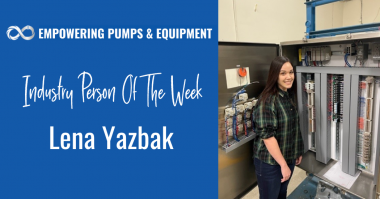Submersible pumps, as the name suggests, are specifically designed so that they can be completely submerged within the liquid which is to be pumped. These specialized pumps are used in a range of industrial and commercial applications, as well as within homes and schools.
The anatomy of a submersible pump
Fitted with waterproof cables which supply power directly to the motor, the system is constructed so that the motor and the turbine bowl are directly attached to each other. A submersible pump is thus a complete unit which features the motor, as well as the mechanical and electrical controls, all enclosed within a frame and cover.
In order to function effectively, the pump must have a significant volume of fluid running through it at any given moment. this maintains the correct temperature and prevents the system from overheating. There are some cases where this cannot occur, as the pump may not be completely submerged. In these instances, a shroud with a closed top can be fitted, this will assist in directing the liquid into the pump.
A submersible pump is used in a similar fashion to other turbine pumps however; changes to the way in which the motor is started are required, as the pump requires additional overload protection. This is to protect the longevity of the pump, as well as to ensure that power is cut immediately if the motor stalls or the impeller becomes jammed. The absence of such a cut-off mechanism could otherwise present the risk of damage to the motor windings.
Operating capacity
Submersible pumps come in a wide range of different sizes, determined by the particular application for which they are intended. Smaller models can be used within homes or in light commercial settings and usually have a power consumption of between .75kw and 2.2kw, accommodating solids to a maximum of 55mm in diameter. For heavier duty applications, such as in construction and industrial applications, larger pumps are available and these can typically handle waste and solids up to 65mm.
The development of submersible pumps
Submersible pumps were first built in Europe and were more commonly seen during the 1950s in the USA. There were some who initially doubted the reliability of submersible models, believing that as they would struggle to work in a full submerged application. However, the first models proved highly successful and the pumps gained popularity in the 1960s. During this same period, the pumps were fitted with a guide rail, which assisted in removing the pump when it needed repairing. As an increasing number of firms started to see the benefits of submersible pumps, their popularity continued to grow. They are now a significant component within many modern pumping stations and in a wide variety of other applications.
Submersible pump applications
Submersible pumps are produced in a range of sizes to suit different applications; they can either be installed as a single unit or as a dual system. In industrial applications, fitting two pumps together is generally the preferred option, as it provides a degree of redundancy if one of the units were to stop working; it reduces the degree of wear and tear on the individual pumps; and it offers greater capacity if required.
One of the main benefits of a submersible pump is that it can be positioned below ground level without causing any access issues. They are thus installed in a range of environments, including:
– Deep wells
– Areas that are prone to flooding
– Where a traditional pump motor could become damaged by contaminated water
– Settings where a quiet pump is necessary
– Where there is limited space
– Agricultural applications
Submersible pumps can also be used in-line in pipelines to boost flow. They can be fitted horizontally in a particular location in the pipe, rather than vertically. They are ideal for use in this type of environment, as they are virtually silent whilst in operation and the motor and electrical components are enclosed to prevent any damage from the fluid.
Inappropriate applications
Whilst submersible pumps have a wide range of uses, there are some instances where they are not an appropriate choice. These include:
– Where the liquid temperature is excessively high
– If the environment is particularly corrosive
– Where there are a significant number of abrasive elements
– Where the fluid contains solids or contaminants of an excessive diameter
Controlling submersible pumps
Each particular system is designed to suit a specific range of applications. This enables the system to be as simple or complex as it needs to be, appropriate to the needs of the environment.
The control system directly manages the level of the liquid within pre-defined parameters and this starts or stops the pump when the liquid reaches the pre-set level. There are generally three different controls within a pump, these turn the pumps on or off, as well as providing an alarm if the fluid exceeds a defined level.
Within a dual pump system, the controls will usually alternate between the two pumps. This type of multiple pump system will also feature an override, which is used to start the second pump if the flow rate cannot be accommodated by a single pump or if the first pump fails.
The development of the submersible pump has resulted in a highly efficient piece of equipment that is extremely safe to use. Once installed, these pumps are reliable and will last for many years and as a result, submersible pumps have become the number one choice in a growing number of domestic and industrial applications. They offer an ideal solution when an electric pump is required in an environment that is either submerged in fluid or which lies below ground level.
Do’s & Don’ts of Domestic Submersible Pumps
For additional guidance, the team at Anchor Pumps have put together a useful list of submersible pump do’s and don’ts to assure safe operation and installation of domestic submersible pumps.
Do read thoroughly all installation information in the manual provided.
DO:
- Do check the pump to make sure it isn’t damaged prior to use.
- Do read thoroughly all installation information in the manual provided.
- Do check the voltage of the pump
- Do check the size of the sump, so the float switch can freely operate
- Do connect to an appropriately protected power supply
- Do make a note of the pump type before fitting in sump – easier if pump fails and is underwater.
- Do try not to place the pump on the bottom of the sump but slightly raised to reduce the chance of the filter blocking
- Do fit a NRV if possible, don’t make the pump work harder than it needs to
- Do make sure the float switch can move unrestricted
- Do make sure the pump filter is cleaned regularly
DON’T:
- Don’t lower the pump down with the power cable
- Don’t fit smaller discharge hose than the pump connection
- Don’t allow water to freeze around the pump
- Don’t allow heavy objects to fall on top of the pump or stop the float switch from operating
- Don’t leave the top of the sump open or uncovered
- Don’t lie the pump on it’s side
- Don’t work or move the pump whilst it is connected to the power supply
- Don’t use the pump to empty swimming pool water if people are in it
- Don’t use the pumps for pumping hydrocarbons (petrol, diesel, fuel oils, etc)
- Don’t allow the pump to run dry
If in doubt ring your supplier and ask for advice, good suppliers will always have a technical support team.
About the Author:
Warren Holmes is the managing director of the pump superstore, Anchor Pumps. Anchor Pumps specialize in both domestic and industrial pumps for the industry’s leading brands including Grundfos, Stuart Turner and Lowara.
For more information visit www.anchorpumps.com.





It’s good to know a bit more about submersible pumps and how they can be positioned below ground and remain accessible. It’s important that you understand pumps like these, both in how they function and where they are positioned, so that you can anticipate what it may take for a contractor to reach it later on if the need arose. Knowing this ahead of time can help you decide on which pump would be best, depending on the time you expect to have it, you finances, and the water access that you would like.
It makes sense that a submersible well pump would be adaptable so you could suit the needs of the environment surrounding it. This would be a really important way of preserving that environment because you wouldn’t have to worry about it harming any creatures or plants by its workings. If there were damage being done then you could just make a few changes to the unit and it would be back to being eco-friendly. Although it would probably be a good idea to talk to a professional before making any changes.
Thanks for helping me learn more about submersible pumps. I didn’t know that these pumps could be ideal in situations where you don’t have a lot of space. That being said, I’m interested to learn more about how much space these pumps will need.
I want to know how can i install a 230v submersinle water pump.
My husband and I have a very deep water well in our backyard and we are thinking about getting a submersible pump, so I am glad that I found this article! You make a great point that these pumps can be positioned below the ground without any issues and this would be great because it would decrease the noise of the pump so we wouldn’t hear it from our house. Also, I appreciate your advice that you should check the voltage of the pump and make sure that you that you connected it to a protected power supply.
My pump has been giving me problems as of late. Now I have tried to fix it myself, but that didn’t work. I think that I should get someone to come out and look at it for me.
Hello Warren,
This is what a real expect’s duty should be. Here, we get a complete guideline concerning the submersible pump. From the past a few months I was looking for these sorts of information. You have written this article very efficiently from my point of view. You discuss many important things, such as the benefits of submersible pumps, operating capacity, development, and submersible pump applications. Moreover, you make the pump installation process easier for us by mentioning here what to do and what we shouldn’t do. Lastly, I really appreciate your research ability and helping nature.
Thanks for explaining that the filter of submersible pumps needs to be cleaned on a regular basis. My husband and I are looking for a pump service to install one for the water well of the home we just purchased. I’m glad I read your article and learned how to keep the pump in good shape once it’s installed!
My aunt has been thinking about getting a pump for her well, so that she can collect more water. She would really like to get some help from a professional to help the system be more effective. I liked what you said about how she should check it’s voltage, size, for any damage, and the pump type.
It’s great that you talked about what a submersible pump is and its uses. In my opinion, it’s interesting to learn about how a submersible pump is used to get water from a deep well. One of my cousins mentioned that his house had a water well problem, I’m not sure if this article could help him, but I’ll be sure to share it with him. Thanks for the information on how a submersible pump has a motor enclosed to avoid damages.